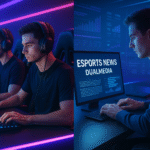In today’s content-driven world, video creation is no longer limited to big-budget studios or large teams. With digital consumption growing across platforms, businesses, creators, and educators are constantly in search of faster, smarter, and more affordable ways to scale video production. One of the most transformative technologies aiding this evolution is AI voice cloning.
AI voice cloning allows content creators to replicate human voices with high accuracy, enabling them to produce consistent voice-overs for videos without repeatedly recording audio. This technology, when combined with AI video editing platforms, opens up an entirely new level of scalability and efficiency for video creation.
The Evolution of Video Creation
From Manual to Automated Production
Video creation has traditionally been a time-consuming and resource-intensive process. It required professional voice artists, expensive recording equipment, post-production specialists, and often several rounds of editing. For creators managing multiple channels, product explainer videos, or instructional content, scaling this process posed a major bottleneck.
Now, with AI-powered tools, many of these manual steps can be significantly reduced or fully automated. Tasks such as script-to-video conversion, voiceover generation, captioning, and editing can be streamlined using artificial intelligence, allowing for much faster production cycles.
The Role of AI Voice Cloning
Among the various innovations, AI voice cloning stands out for its ability to replicate a person’s voice with remarkable accuracy and emotional tone. It uses deep learning models trained on voice data to synthesize speech that sounds just like a real human. When integrated into platforms like invideo AI, it becomes possible to reuse the same cloned voice across multiple videos, maintaining consistency and personalization at scale.
Rather than relying on a voice artist to record each video script, creators can simply type the script and let the AI generate the audio using the cloned voice. This eliminates the need for studio time, editing delays, or human re-recordings, especially when minor script changes occur.
Key Benefits of AI Voice Cloning for Video Creation
1. Consistency Across All Content
Brands and creators often seek a consistent tone and voice in all their content. With voice cloning, the same voice can be replicated in dozens or even hundreds of videos, creating a uniform auditory identity across platforms.
This consistency is particularly valuable for businesses that publish training modules, explainer videos, or customer onboarding content, where shifting vocal tones or styles can be distracting or unprofessional.
2. Faster Production Timelines
By eliminating the need to record and re-record audio, voice cloning can drastically reduce production timelines. Script revisions no longer require a voice actor to come back for another session. A simple text change can be processed through the AI and rendered into an updated voiceover in minutes.
This capability is particularly useful for marketers running time-sensitive campaigns, educators updating learning materials, or social media creators posting daily content.
3. Cost-Effective Scaling
Hiring professional voice actors for every video project can be expensive, especially when working in multiple languages or regional dialects. With AI voice cloning, the upfront cost of training a model on a voice sample is quickly offset by the ability to reuse it endlessly.
Small teams, startups, and independent creators benefit the most, as they can scale up production without increasing their budgets proportionally.
4. Multilingual Voice Generation
Some AI voice cloning systems now support multilingual capabilities. This means the same cloned voice can be used to deliver scripts in different languages, allowing businesses to reach global audiences with a single voice identity.
This is particularly useful for international training content, multilingual marketing, or customer support video segments that have traditionally required separate recordings and native speakers.
Enhancing Creativity with AI Video Apps
The rise of AI video apps has made video creation more accessible and intuitive. These platforms allow users to generate professional-grade videos with minimal technical skills, combining tools like voiceover generation, automatic editing, background music, transitions, and more.
When paired with AI voice cloning, these apps empower users to build videos from text scripts, turning written ideas into full multimedia experiences. For example, a marketing team can create multiple product videos in different tones (educational, persuasive, conversational) using the same cloned voice, ensuring message consistency while tailoring the emotional delivery.
This synergy between AI voice cloning and video creation tools helps both amateur and professional creators produce content at scale, without sacrificing quality.
Real-World Applications Across Industries
1. Education and E-learning
Educators can now generate hours of narrated video lessons without the need to record audio for each one. By cloning their own voice, teachers maintain a familiar presence in the content, helping students stay engaged. Plus, any updates to course material can be voiced within minutes.
2. Marketing and Advertising
In digital marketing, speed is crucial. Brands can use AI voice cloning to roll out quick-turnaround campaigns with voiceovers that match their tone. Variations for A/B testing, different regional accents, or quick messaging pivots become easy to execute.
3. Corporate Training and Internal Communication
Companies producing internal training videos, onboarding modules, or CEO messages can use AI to generate polished, voice-consistent videos on demand. Leaders can clone their voice for important messages, ensuring clarity and engagement across large teams.
4. Content Creation for YouTube and Social Media
Creators who post regularly on platforms like YouTube, Instagram, and TikTok benefit greatly. Instead of recording every voiceover from scratch, they can automate narration using their AI-generated voice, freeing time for idea generation and video editing.
Looking Ahead: The Future of Voice in Video Creation
As the technology matures, AI voice cloning will continue to improve in realism and emotional expression. Soon, we may see tools that allow creators to direct cloned voices like actors, modifying tone, pitch, and pace for different scenes or moods.
Integration with virtual avatars, real-time video generation, and interactive media could lead to even more immersive content. Think of AI-powered customer support bots that not only speak in the brand’s voice but also appear as avatars, or virtual teachers conducting live classes in multiple languages.
The boundary between human and AI-generated voice will blur—but with ethical safeguards and creative intent, this evolution promises to empower rather than replace human storytellers.
Conclusion
AI voice cloning is no longer just a futuristic concept; it’s a practical tool that is reshaping how videos are produced at scale. By enabling consistent, fast, and cost-effective voice generation, it addresses one of the most time-consuming aspects of video production.
When combined with powerful platforms like invideo AI, content creators can seamlessly transform written scripts into high-quality videos without compromising on voice quality or branding. With AI video apps becoming more intelligent and accessible, the future of scalable video creation looks brighter and much more efficient.
For creators, marketers, and educators alike, adopting these tools means more time for creativity and less time spent on logistics. As AI voice cloning continues to evolve, it’s not just changing how we make videos, it’s changing what’s possible.








